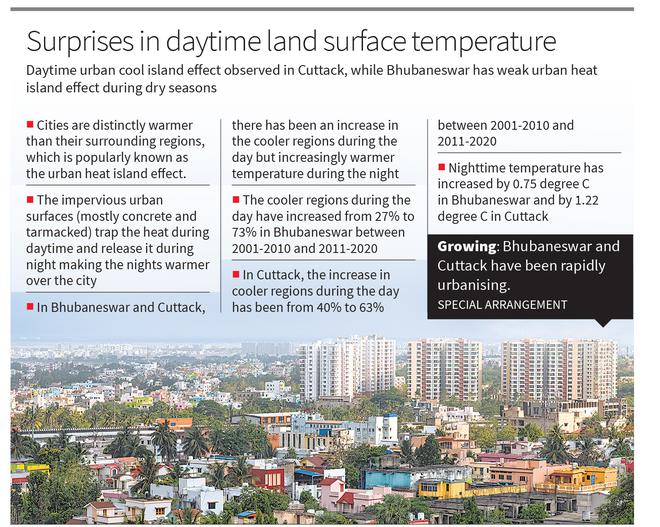A recent study by researchers from the School of Earth Ocean and Climate Sciences at IIT Bhubaneswar has found that increased urbanisation of Bhubaneswar and Cuttack has led to increased land surface temperature in the last 20 years (2001-2020). While there has been an increase in relatively cooler regions over Bhubaneswar and Cuttack during daytime, the reverse is seen during night time. However, during the night, both cities have been witnessing increased urban heat island effect. As a result, there has been a reduced daytime and night time temperature difference.
The results of the study have been published in the journal Environment, Development and Sustainability.
“The urban areas of Bhubaneswar and Cuttack are about 0.75 degree C and 1.22 degree C warmer than the surrounding rural areas, respectively. The core city area is warmer than the recently developed suburban regions. The temperature changes over the last two decades have been more rapid in the suburban areas in the two cities, and suburbs experience almost twice the warming than by the entire city,” says Dr. V. Vinoj, who is the corresponding authors of the paper.
Overall, the daytime land surface temperature for Bhubaneswar and Cuttack was over 32 degrees C. The increase in relatively cooler regions during the daytime has been from 27% and 40% (2001-2010) to 73% and 63% (2011-2020) in Bhubaneswar and Cuttack, respectively. This can be attributed to an almost 2.7 and 1.6 times increase in the cooler fractional land cover during the daytime in Bhubaneswar and Cuttack, respectively.
Bhubaneswar and Cuttack are not the only cities that witnessed a drop in daytime land surface temperature. Studies published in 2020 and 2021 have reported a similar phenomenon for both urban and surrounding non-urban regions in Pune.
Intriguing
“It is not clear why there is a decline in daytime land surface temperature,” says Dr. Vinoj. “This decline may be due to multiple reasons but we have still not explored them. They may be due to an increase in clouds, increased air pollution/haziness, increased vegetation or any other things. Further analysis is required to determine the major factors driving such changes. But warming during night time is only affected by heat emitted by surface. Urban areas due to their ability to trap heat emits them slowly leading to a warming pattern above cities.”
Dr. Vinoj adds: “One thing to remember is that this is a large-scale feature mostly a consequence of regional climate change and not local change.”
In contrast, there has been a clear increase in night time temperature leading to 0.75 degree C surface urban heat island intensity (SUHI) during the night in Bhubaneswar and 1.22 degree C increase in SUHI for Cuttack. The two cities have recorded a growth rate of 0.18 degree C and 0.13 degree C per decade during the night, respectively. The night time land surface temperature reached a maximum of over 23 degrees C. The largest changes in trend can be seen in the city’s periphery as a result of urban sprawl. In the core part of both cities, it is confined to a small region with dense built-up areas.

Possible reasons
The changing patterns and the features of urban induced warming is quite clear during night time, but a bit tricky during daytime. For example, a daytime urban cool island is observed over Cuttack during winter and pre-monsoon seasons. Such urban cool islands have been reported previously over the cities in arid and semi-arid regions. “We find that the unique geographic location of Cuttack, surrounded by rivers which dries up during pre-monsoon and winter months, exposes the sand beds (creating a desert city like condition) leading to this phenomenon with more warming in the surrounding regions,” says Dr. Vinoj. “Bhubaneswar is also seen to have weak daytime heat island effect during the dry seasons with decreased green cover in the surrounding areas. Nights are warmer over the cities compared with the surrounding regions whereas during daytime, surrounding regions are warming along with the cities.”
During the period 2001-2010, the area with night time land surface temperature higher than the 20-year climatological value for Bhubaneswar and Cuttack was 37% and 48%, respectively. But it increased to nearly 60% and 63% between 2011-2020 in Bhubaneswar and Cuttack, respectively. This indicates a higher expansion in the hotspot area for Bhubaneswar compared with Cuttack. “The higher increase seen in Bhubaneswar is due to unconstrained growth compared with Cuttack, where the growth is constrained by the rivers surrounding it,” says Soumya Satyakanta Sethi, a PhD student and the first author of the paper.
“Changes of this kind even in tier-2 cities show that urban heat island effect is not restricted to larger cities. But it also provides hope that with proper urban planning, newer and smaller developing cities can reduce urban heat island effect, and hence the vulnerability to heat in the future,” Dr. Vinoj says.







